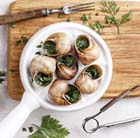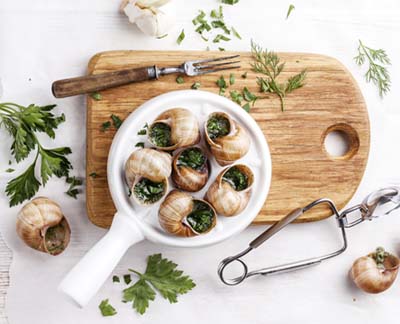Snails: Great with spaghetti
Country Life visits a snail farm and finds these local British delicacies are great with spaghetti


They really are like miniature pearls. Iridescent, glistening, tiny off-white spheres clustered on my spoon. These are snail pearls-eggs, to you and me-and I'm about to have my first taste of snail caviar.
‘Go on,' encourages Sophie Wharton, giggling at the look on my face. ‘Try it.' And so I do. A creamy, earthy taste fills my mouth. Not overpowering, but full-flavoured, truffly and quite delicious. Sophie and her husband, Michael, run one of only four snail farms in England. Their Buckinghamshire base in Aylesbury has been purpose-built to house a commercial kitchen, a hatchery, a walk-in snail dormitory and a 30ft polytunnel of mollusc love. During the summer months, the snails-cousins of our own common-or-garden snail-wander hither and thither on their own free range farm in nearby Wendover.
This labour of love grew from a childhood fascination with snails and a fateful internet-browsing session. ‘It sort of happened by accident, four years ago,' Sophie says. ‘I saw an article on snails and how to keep a few of your own and, on a whim, I bought some. And from that moment on, things just haven't stopped.'
The snails arrived, bred, outgrew their box and, suddenly, the race was on to house them. Within months, Sophie was changing career from the insurance sector to full-scale snail farming. Her passion for the humble Helix aspersa maxima now sees her ship hundreds of them every day to the UK's catering trade.
‘It's taken over our lives,' she admits as we enter the 30ft polytube that forms the snail-breeding tunnel. Inside, there are thousands of snails slithering silently across sections of raised wooden beds. ‘My husband is a carpenter and he's been put to good use, I can tell you. We started with a few crates, then boxes, then tunnels, sheds, fields. They breed like mad and we had to keep up!'
In this plastic, heated love nest, the snails are kept warm, dry, fed and watered. Here, they can produce up to 5lb of eggs (or pearls) between them every four days. During the summer months, the hatchlings produced by the breeders in the tunnel are moved out to rape fields where they dine alfresco. They're penned and netted for protection and a ‘harvest' takes place in October when hundreds of thousands of the little slitherers need to be collected by hand.
When they've grown from tiny pearls to hefty snails, the plumpest are selected, purged and cooled in net bags so that they ‘sleep' or hibernate before being blanched in Sophie's state-of-the-art Escargot Development Kitchen. The meat is picked from the shells and vacuum-packed into bags ready for postage.
Exquisite houses, the beauty of Nature, and how to get the most from your life, straight to your inbox.
The Whartons' company, Aylesbury Escargots, currently farms about a half a million snails every year. Mickael Weiss, head chef of London's Coq D'Argent, is among the fans of these Aylesbury Escargots, as is Phil Fanning, owner and head chef of Paris House restaurant on the nearby Woburn Abbey estate. ‘I mean it when I say I really love these snails,' he says. ‘Their flavour is second to none and we've even created our own dish-The Snail Garden-to showcase them.'

Escargots are, of course, a common dish in France and Sophie has visited a snail college there to take advice from French ‘growers'. And so effective are her techniques, Gallic growers have returned the favour and travelled to Aylesbury to see how she runs her operation. ‘There is so much to learn,' she admits. ‘Each new stage is a learning curve and you make discoveries as you go along. It makes me cringe to think of the mistakes we made, but we had to start somewhere.'
The snails themselves are traditionally served in the shell, smothered in garlic butter, but there are myriad other ways they can be presented to fine diners. Of course, I can't leave without trying them fresh. Sophie selects some juicy specimens and presents them in an edible crumb shell with a healthy dollop of garlic butter and fennel. I cast an apprehensive eye in their direction as they gently cook for 10 minutes or so in the oven and they're set before me with a flourish.
Free-range English snails, fresh out of the shell. With an instant and hefty belt of garlic, they taste superb; gently yielding like well-cooked squid and with a deep, faintly mushroomy flavour. I pop another, and another.
‘They're great with spaghetti,' says Sophie cheerfully, as she hauls up another net bag of spiralshelled beauties ready for the oven. ‘And, for some reason, the pearls go brilliantly with beetroot.'
And why not? Snail caviar and beetroot. There's an English appetiser for you. Aylesbury Escargots: 01296 482585; www.aylesbury-escargots.co.uk
Snail pearls with beetroot salad and buckwheat blinis
Ingredients
For the blinis 150g milk 8g fresh yeast 75g buckwheat flour 50g plain flour 1 egg yolk 150g egg white
For the salad
1 small baked beetroot, finely diced 1 small granny smith apple, finely diced 25g of escargot pearls 1tspn of thyme leaves 1tblspn vinaigrette Sea salt to taste
Method
Whisk the blini ingredients together and leave, covered, overnight in the fridge.
When ready to serve, spoon small dots of batter into a medium-hot frying pan with a small amount of oil and cook until they're golden on both sides.
Mix the salad ingredients together and spoon a generous helping of pearls onto a blini. Enjoy with some fizz.
* Follow Country Life on Twitter
Country Life is unlike any other magazine: the only glossy weekly on the newsstand and the only magazine that has been guest-edited by His Majesty The King not once, but twice. It is a celebration of modern rural life and all its diverse joys and pleasures — that was first published in Queen Victoria's Diamond Jubilee year. Our eclectic mixture of witty and informative content — from the most up-to-date property news and commentary and a coveted glimpse inside some of the UK's best houses and gardens, to gardening, the arts and interior design, written by experts in their field — still cannot be found in print or online, anywhere else.
